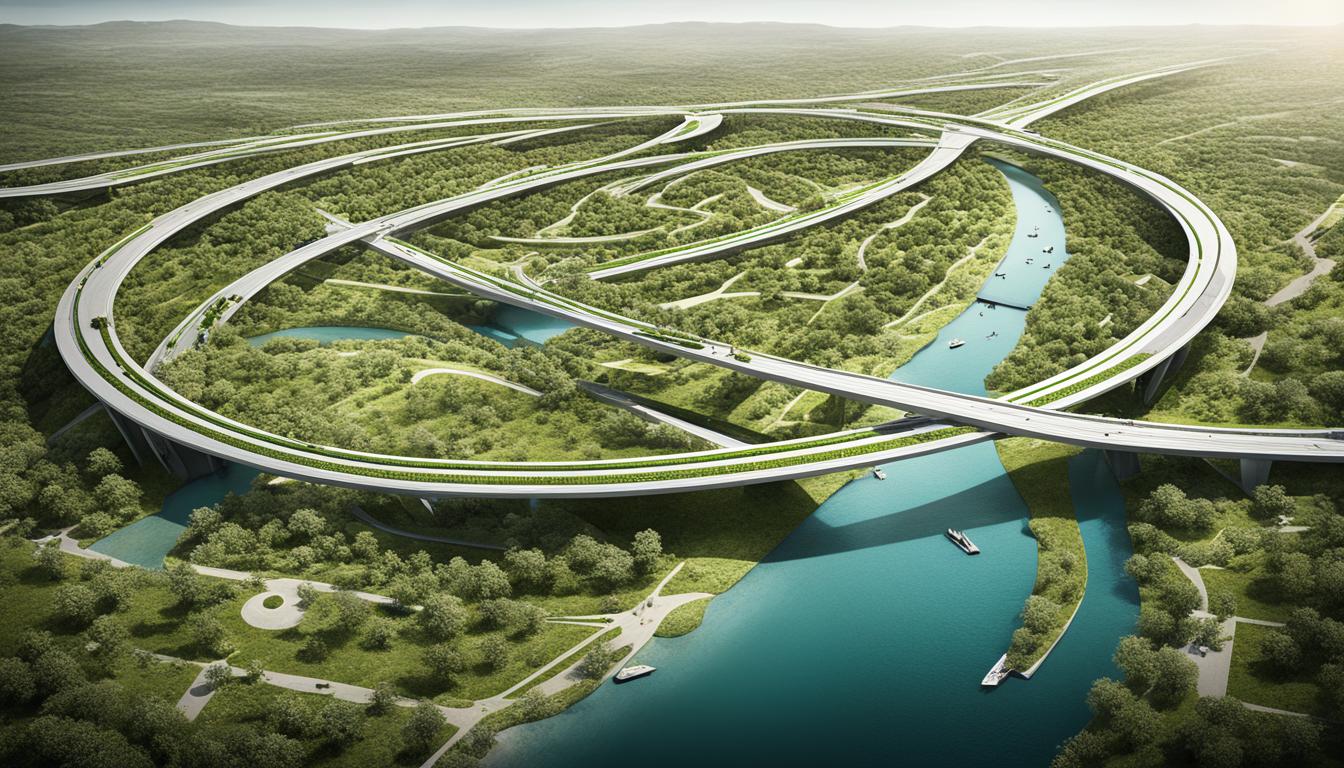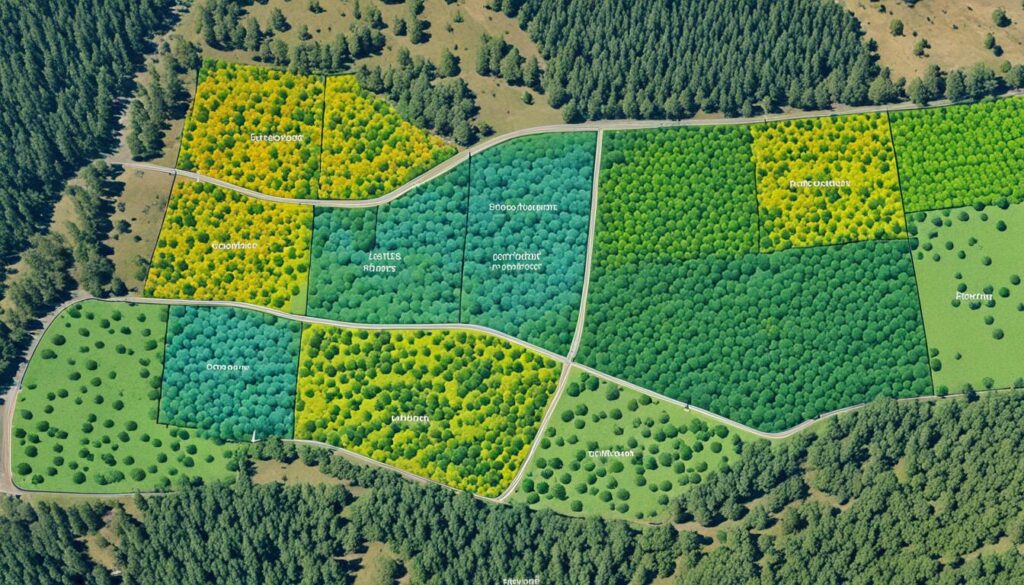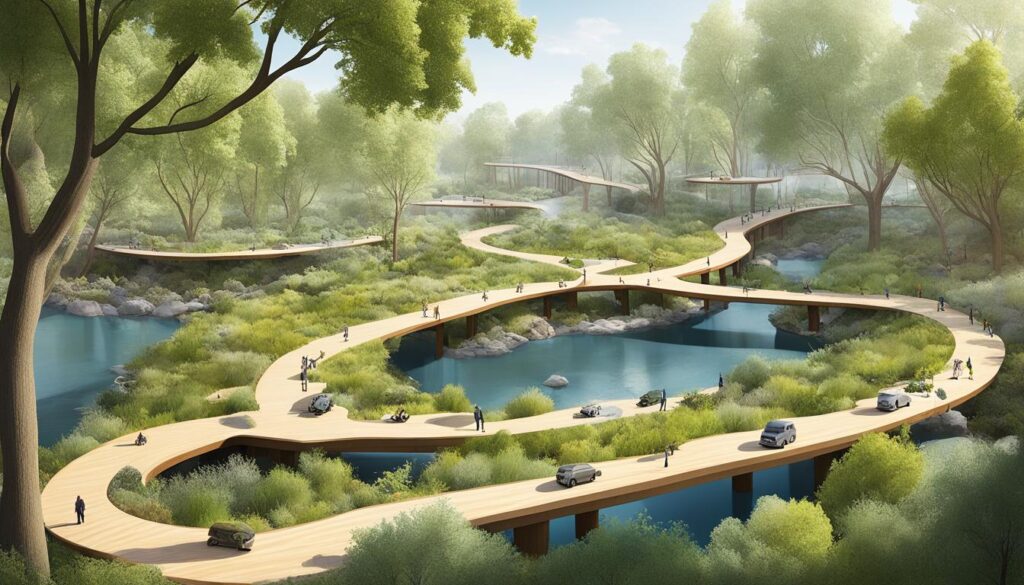
When it comes to protecting and enhancing biodiversity in our urban landscapes, architectural solutions can make a significant difference. By incorporating sustainable design practices and eco-friendly architecture, we can create green infrastructure solutions that promote habitat connectivity and support urban biodiversity. Let me share a story that illustrates the importance of these architectural solutions.
Meet Sarah, a passionate architect who believes in the power of design to create a harmonious coexistence between humans and nature. Growing up in a bustling city, Sarah often longed for a connection with the natural world. She witnessed the gradual disappearance of green spaces and the fragmentation of habitats, leading to a decline in wildlife populations.
Determined to make a change, Sarah decided to focus her architectural career on finding solutions to enhance biodiversity connectivity in urban areas. She embarked on a journey to learn about habitat connectivity design, green urban planning, and landscape design for wildlife connectivity.
One day, Sarah was approached by the local government to design a new residential development on the outskirts of the city. The location was a former industrial site with limited green spaces and fragmented habitats. Sarah saw this project as an opportunity to create a blueprint for sustainable, eco-friendly architecture that would prioritize habitat connectivity.
Working closely with ecologists and landscape designers, Sarah developed a plan that included the creation of green corridors throughout the development. These corridors would provide safe passage for wildlife, connecting existing habitats and ensuring their long-term viability. The design also incorporated native plants and diverse vegetation to attract a wide range of species and provide essential resources.
As the development took shape, Sarah witnessed a remarkable transformation. Once-barren land became a vibrant ecosystem, buzzing with life. Birds nested in the trees, butterflies danced in the meadows, and small mammals found refuge in the carefully designed habitats. The residents of the development also benefited from the lush green spaces, enjoying the beauty of nature on their doorsteps.
Sarah’s project became a shining example of how architectural solutions can contribute to the conservation of urban biodiversity. Through her innovative approach, she not only created a sustainable and environmentally friendly development but also fostered a stronger connection between humans and the natural world.
Key Takeaways:
- Architectural solutions can enhance biodiversity connectivity in urban landscapes.
- Sustainable design practices and eco-friendly architecture are crucial in promoting habitat connectivity.
- Green infrastructure solutions, such as creating green corridors, support urban biodiversity.
- Landscape design for wildlife connectivity and green urban planning are essential components of architectural solutions for biodiversity connectivity.
- By prioritizing habitat connectivity, architectural solutions contribute to the conservation of urban biodiversity and improve the well-being of both humans and wildlife.
The Importance of Habitats and Corridors for Wildlife
Habitats and corridors are vital for wildlife as they provide essential resources like food, shelter, water, and breeding opportunities. They also allow for safe and efficient movement across the landscape. Enhancing the ecological value and diversity of a project with habitats and corridors offers a range of benefits for both wildlife and humans.
- Reducing habitat fragmentation: Habitats and corridors connect fragmented landscapes, allowing wildlife to move freely and access different resources.
- Increasing wildlife population viability: By providing suitable habitats and connected corridors, wildlife populations have a greater chance of survival and long-term viability.
- Enhancing genetic diversity: Habitats and corridors support gene flow between populations, preventing inbreeding and promoting genetic diversity.
- Providing ecosystem services: Healthy habitats and connected corridors contribute to ecosystem services such as pollination, nutrient cycling, and pest control.
- Improving human well-being: Access to habitats and corridors promotes human well-being through recreation, education, and nature connection.
Creating habitats and corridors in architectural and landscape designs is essential for conserving biodiversity, supporting wildlife populations, and ensuring the overall health of ecosystems. It is crucial to prioritize habitat connectivity and design projects that minimize habitat fragmentation, maximize genetic exchange, and provide a range of ecosystem services for the benefit of both wildlife and human communities.

In the image above, you can see the importance of habitats and corridors in providing resources and connectivity for wildlife.
Assessing and Selecting Suitable Habitats and Corridors
Before designing habitats and corridors, it’s important to assess the existing conditions and potential of the site. This involves conducting site surveys, inventories, and utilizing GIS mapping to gather valuable data.
Site surveys and inventories allow us to identify key factors such as the current vegetation, soil composition, hydrology, topography, and existing wildlife populations. Understanding these elements is crucial in determining the suitability of habitats and corridors for biodiversity connectivity.
Utilizing GIS mapping technology provides us with a comprehensive view of the site, allowing us to analyze spatial data and identify potential areas of interest. By overlaying different layers of information, such as habitat features and landscape elements, we can gain insights into the spatial relationships within the site.
To evaluate the quality, function, and suitability of habitats and corridors, we employ ecological models and indicators. These models help us assess various factors, including habitat connectivity, species requirements, and potential barriers to movement. By using objective metrics, we can make informed decisions based on ecological data and scientific principles.
When selecting appropriate habitats and corridors, it’s essential to consider a range of factors. These include project goals, client objectives, local climate conditions, site ecology, available space, budget constraints, and maintenance resources. Taking these factors into account ensures that the chosen habitats and corridors are well-suited to support the desired wildlife populations and promote ecological connectivity.
Evaluating Suitable Habitats and Corridors: Key Considerations
- Project goals and client objectives
- Local climate conditions and site ecology
- Available space and budget constraints
- Maintenance resources and long-term sustainability
By conducting thorough assessments, leveraging advanced technologies, and using ecological models and indicators, we can make informed decisions when selecting suitable habitats and corridors for biodiversity connectivity. This comprehensive approach ensures that the designed solutions align with both ecological and project requirements, promoting successful outcomes for wildlife and the surrounding environment.

Designing Functional Habitats and Corridors
Once the habitats and corridors are selected, the next step is to design them using various principles that promote their functionality and effectiveness. Habitat design and corridor design are crucial elements in creating thriving ecosystems and enabling the movement of wildlife. Let’s explore the important aspects of habitat and corridor design:
Planting Design Principles
A key consideration in habitat design is selecting and arranging plants that provide the necessary resources for wildlife. Native and adapted plants are preferred as they are well-suited to the local environment and support a diverse range of species. By incorporating these plants, habitats can mimic natural ecosystems and enhance their ecological value.

Diverse and Layered Plant Communities
To create robust habitats, it is important to establish diverse and layered plant communities. By combining plants of different heights, textures, and leaf structures, a variety of resources such as food, shelter, and nesting sites can be made available to wildlife. This approach provides niches for a wide range of species and promotes biodiversity.
Structural and Spatial Diversity
Structural and spatial diversity is essential in habitat design to create complexity and maximize the habitat’s potential. Varying the arrangement of plants, incorporating different vegetation layers, and introducing structural elements like logs or rocks can create diverse microhabitats within the larger habitat. This diversity caters to the varying needs of different species and enhances overall ecological functionality.
Seasonal and Successional Changes
Designing habitats that offer resources throughout the year is crucial for supporting wildlife populations. By selecting plants that bloom and fruit at different times, habitats can provide a consistent supply of food and shelter as seasons change. Additionally, incorporating successional changes allows for the continuous development of the habitat, ensuring its long-term viability.
Optimizing Corridor Design
Corridor design involves careful planning to optimize their functionality and performance. Considerations such as size, shape, orientation, distance, width, and continuity of corridors play a crucial role in facilitating wildlife movement. Corridors should be strategically designed to connect habitat patches effectively, minimizing barriers and providing safe passage for species.
By applying these habitat and corridor design principles, architects and designers can create functional and resilient ecosystems that support a diverse range of wildlife. The craftsmanship and attention to detail in habitat design not only enhance ecological connectivity but also contribute to the overall beauty and sustainability of the landscape.
Monitoring and Managing Habitats and Corridors
Once habitats and corridors are implemented, monitoring and management are crucial for their long-term success and sustainability. It is important to track the progress and effectiveness of these conservation efforts to ensure that the desired outcomes are achieved. Effective habitat monitoring and management involve the use of performance indicators, adaptive management strategies, and stakeholder engagement and education.
Performance Indicators
Performance indicators are essential tools for evaluating the performance and effectiveness of habitats and corridors. These indicators measure specific outcomes and impacts, providing valuable insights into the conservation efforts. By establishing clear and measurable indicators, stakeholders can assess the success of the project and make informed decisions regarding future management actions.
- Examples of performance indicators for habitat monitoring include:
- Population size and distribution of target species
- Vegetation cover and diversity
- Water quality and availability
- Connectivity and permeability of corridors
- Presence and abundance of indicator species
Adaptive Management Strategies
Adaptive management is a flexible and iterative approach that allows for adjustments and improvements based on monitoring results. It involves regularly reviewing and updating management plans to ensure that they remain effective and responsive to changing conditions. By adopting adaptive management strategies, stakeholders can address emerging challenges, refine conservation techniques, and optimize habitat and corridor design.
Some examples of adaptive management strategies include:
- Regular monitoring and data collection
- Analysis and interpretation of monitoring data
- Identification of potential issues or gaps in management
- Implementation of appropriate modifications or interventions
- Periodic evaluation of the effectiveness of management actions
Stakeholder Engagement and Education
Stakeholder engagement and education are integral to the success of habitat monitoring and management efforts. By involving and informing users, managers, and beneficiaries of habitats and corridors, stakeholders can develop a shared understanding of the project’s goals and objectives. Stakeholder engagement fosters collaboration, encourages ownership, and strengthens support for the conservation initiatives.
“Stakeholder engagement promotes a sense of collective responsibility for the habitats and corridors, ensuring their long-term viability and sustainability.” – Jane Carter, Environmental Scientist
Education plays a vital role in creating awareness and building capacity among stakeholders. By providing knowledge about the importance of habitats and corridors, their value to biodiversity, and the ongoing management practices, stakeholders can make informed decisions and actively contribute to the conservation efforts.

By implementing robust monitoring and management practices, habitats and corridors can thrive, providing essential resources and contributing to the conservation of biodiversity. The combined efforts of performance monitoring, adaptive management strategies, and stakeholder engagement and education are key to ensuring the long-term success of these valuable conservation initiatives.
The Role of Ecological Corridors in Biodiversity Conservation
Ecological corridors are instrumental in the conservation of biodiversity, as they enable gene flow and facilitate the movement of species between different habitat patches. These corridors play a crucial role in enhancing species richness and promoting ecosystem stability, contributing to the long-term viability of populations and the overall health of ecosystems.
By providing pathways for migratory movements, dispersal, and colonization, ecological corridors ensure the exchange of genetic material and the persistence of essential ecological and evolutionary processes. They create ecological connectivity, allowing diverse species to thrive and adapt to environmental changes.
Furthermore, ecological corridors support the conservation of endangered or vulnerable species by providing safe and unobstructed routes for their movement. This enables them to access essential resources, such as food, water, and suitable breeding sites, which might otherwise be fragmented or inaccessible.
Research has shown that ecological corridors are vital for the survival of migratory animals, enabling successful navigation across vast landscapes and promoting their long-term population viability. By facilitating gene flow, these corridors also prevent genetic isolation and inbreeding, which can lead to reduced genetic diversity and increased vulnerability to diseases and environmental stressors.

Moreover, the presence of ecological corridors has wider implications for ecosystem functioning. These corridors allow for the movement of key species, such as pollinators and seed dispersers, which are essential for maintaining plant diversity and promoting ecological interactions. They also facilitate the migration of species in response to climate change, thereby aiding ecosystem resilience and adaptation.
Overall, ecological corridors are indispensable tools in the conservation of biodiversity. By creating interconnected networks of habitats, they support the movement of species, enhance genetic diversity, and promote ecosystem stability. These corridors play a vital role in maintaining the health and integrity of ecosystems, ensuring the coexistence and survival of both wildlife and humans.
Challenges and Opportunities in Ecological Corridor Design
Designing effective ecological corridors poses several challenges that need to be addressed in order to achieve a successful design. These challenges involve balancing the needs of human development with biodiversity conservation, mitigating habitat fragmentation, and integrating ecological planning and landscape connectivity.
One of the main challenges is striking a balance between fulfilling human needs for development and ensuring the preservation of biodiversity. This requires careful consideration and planning to minimize the negative impacts of human activities on wildlife habitats and corridors.
Habitat fragmentation is another significant challenge that needs to be addressed in corridor design. Fragmentation occurs when natural habitats are divided into smaller and isolated patches, limiting the movement of wildlife between these areas. Mitigating habitat fragmentation in corridor design involves creating connected and continuous pathways that allow for the movement of species and the exchange of genetic material.
Integrating ecological planning and landscape connectivity is essential to ensure the functionality and effectiveness of ecological corridors. This requires considering the broader landscape context and identifying strategic locations for corridor placement to maximize connectivity and promote species movement.
Designing ecological corridors also requires interdisciplinary collaboration between architects, ecologists, planners, and other professionals. By working together, these experts can bring their respective knowledge and expertise to develop innovative solutions that consider both ecological and human needs.
While these challenges may seem daunting, they also present opportunities for creating sustainable and environmentally friendly designs. By prioritizing landscape connectivity and biodiversity conservation, ecological corridors can be designed to benefit both wildlife and human communities. This includes integrating green infrastructure, such as parks and green spaces, into corridor design to enhance ecological connectivity and promote sustainable development practices.

“Designing ecological corridors is a complex task that requires us to balance the needs of human development with the conservation of biodiversity. By overcoming these challenges, we can create innovative solutions that promote landscape connectivity, ecological planning, and interdisciplinary collaboration.”
| Challenges in Ecological Corridor Design | Opportunities in Ecological Corridor Design |
|---|---|
| 1. Balancing human needs with biodiversity conservation | 1. Integration of green infrastructure |
| 2. Mitigating habitat fragmentation | 2. Promotion of sustainable development practices |
| 3. Integrating ecological planning and landscape connectivity | 3. Enhancement of ecological connectivity |
| 4. Interdisciplinary collaboration | 4. Innovation in corridor design |
By addressing these challenges and embracing these opportunities, we can design ecological corridors that not only support biodiversity conservation but also contribute to the well-being and sustainability of our communities.
Landscape Connectivity and the Role of Green Infrastructure
Landscape connectivity plays a vital role in the conservation of biodiversity in urban environments. One important aspect of landscape connectivity is the integration of green infrastructure, which includes parks, green spaces, and ecological networks. Green infrastructure acts as a corridor, facilitating wildlife movement and promoting the coexistence of humans and nature.
Green infrastructure offers a range of benefits that contribute to the conservation of biodiversity. Firstly, it improves air and water quality, creating a healthier environment for both wildlife and humans. By reducing pollutants and providing natural filtration systems, green infrastructure helps sustain ecological balance.
Moreover, green infrastructure plays a crucial role in reducing the urban heat island effect. With the increasing density of urban settings, the temperature rises, putting stress on both wildlife and people. Green spaces act as natural air conditioners, mitigating the negative impacts of urban heat and providing a more pleasant and cool environment.
One of the key advantages of green infrastructure is its ability to enhance urban biodiversity. By providing suitable habitats and resources for diverse species, green spaces support a wide range of plants, birds, insects, and other wildlife. This rich variety of species creates a thriving ecological network that strengthens the overall resilience of the urban ecosystem.
Incorporating green infrastructure into urban planning and design is essential for creating sustainable and biodiverse cities. Architects have a crucial role to play in this process. By incorporating green infrastructure elements such as green roofs, vertical gardens, and wildlife-friendly landscapes into their designs, architects can contribute to the creation of cities that prioritize landscape connectivity and biodiversity conservation.
“Green infrastructure acts as a bridge between urban areas and natural habitats, providing essential connections for wildlife movement and ensuring the survival of various species.”
As urbanization continues to expand, the importance of green infrastructure cannot be overstated. It creates ecological networks that connect fragmented habitats, allowing species to disperse, migrate, and colonize new areas. This connectivity is vital for preserving genetic diversity, enhancing population viability, and sustaining ecological processes.
To showcase the significance of green infrastructure in landscape connectivity and biodiversity conservation, the table below highlights some of the key benefits:
| Benefits of Green Infrastructure |
|---|
| Improves air and water quality |
| Reduces urban heat island effect |
| Enhances urban biodiversity |
| Increases overall ecological resilience |
The table clearly demonstrates how green infrastructure contributes to the well-being of urban environments by providing multiple benefits for both wildlife and humans. By recognizing the role of green infrastructure and incorporating it into urban planning and design, architects can create sustainable and biodiverse cities that prioritize landscape connectivity and ensure the long-term conservation of biodiversity.
Conclusion
Architectural solutions for biodiversity connectivity are essential in creating resilient and biodiverse urban environments. By incorporating sustainable design solutions that prioritize landscape connectivity and green infrastructure, architects can play a crucial role in enhancing ecological connectivity and promoting the conservation of urban biodiversity.
Creating habitats and corridors through architectural solutions helps reduce habitat fragmentation, increase wildlife population viability, and enhance genetic diversity. By integrating green infrastructure into their designs, architects can create spaces that not only benefit wildlife but also provide numerous benefits to human communities.
Through interdisciplinary collaboration and a focus on ecological planning, architects can design innovative solutions that foster ecological connectivity, urban biodiversity, and sustainable development. By embracing these architectural solutions, we can create a harmonious coexistence between humans and nature, ensuring the well-being of both.

